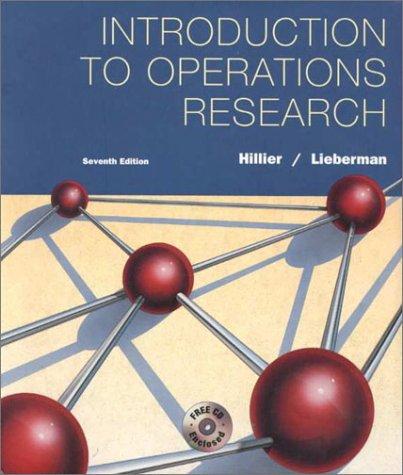After further negotiations with each vendor, management of the G. A. Tanner Co. has learned that either
Question:
After further negotiations with each vendor, management of the G. A. Tanner Co. has learned that either of them would be willing to consider increasing their supply of their respective subassemblies over the previously stated maxima (3,000 subassemblies of type A per day and 1,000 of type B per day) if the company would pay a small premium over the regular price for the extra subassemblies. The size of the premium for each type of subassembly remains to be negotiated. The demand for the toy being produced is sufficiently high that 2,500 per day could be sold if the supply of subassemblies could be increased enough to support this production rate. Assume that the original estimates of unit profits given in Prob. 6.7-7 are accurate.
(a) Formulate a linear programming model for this problem with the original maximum supply levels and the additional constraint that no more than 2,500 toys should be produced per day. Then use the graphical method to obtain its optimal solution.
C
(b) Use a software package based on the simplex method to solve for an optimal solution.
C
(c) Without considering the premium, use the same software package to determine the shadow price for the subassembly A constraint by solving the model again after increasing the maximum supply by 1. Use this shadow price to determine the maximum premium that the company should be willing to pay for each subassembly of this type.
C
(d) Repeat part
(c) for the subassembly B constraint.
C
(e) Estimate how much the maximum supply of subassemblies of type A could be increased before the shadow price (and the corresponding premium) found in part
(c) would no longer be valid by using the same software package to resolve for an optimal solution and the total profit (excluding the premium) as the maximum supply increases in increments of 100 from 3,000 to 4,000.
C
(f) Repeat part
(e) for subassemblies of type B by re-solving as the maximum supply increases in increments of 100 from 1,000 to 2,000.
C (g) Use the same software package to generate the usual output
(as in Table 6.23) for sensitivity analysis of the supplies being made available of the subassemblies. Use this output to obtain the allowable range to stay feasible for each subassembly supply.
(h) Use graphical analysis to verify the allowable ranges obtained in part (g).
(i) For each of the four combinations where the maximum supply of subassembly A is either 3,500 or 4,000 and the maximum supply of subassembly B is either 1,500 or 2,000, use the 100 percent rule for simultaneous changes in right-hand sides to determine whether the original shadow prices definitely will still be valid.
(j) For each of the combinations considered in part (i) where it was found that the original shadow prices are not guaranteed to still be valid, use graphical analysis to determine whether these shadow prices actually are still valid for predicting the effect of changing the right-hand sides.
C 6.7-9 Consider the Distribution Unlimited Co. problem presented in Sec. 3.4 and summarized in Fig. 3.13.
Although Fig. 3.13 gives estimated unit costs for shipping through the various shipping lanes, there actually is some uncertainty about what these unit costs will turn out to be. Therefore, before adopting the optimal solution given at the end of Sec. 3.4, management wants additional information about the effect of inaccuracies in estimating these unit costs.
Use a computer package based on the simplex method to generate sensitivity analysis information preparatory to addressing the following questions.
(a) Which of the unit shipping costs given in Fig. 3.13 has the smallest margin for error without invalidating the optimal solution given in Sec. 3.4? Where should the greatest effort be placed in estimating the unit shipping costs?
(b) What is the allowable range to stay optimal for each of the unit shipping costs?
(c) How should these allowable ranges be interpreted to management?
(d) If the estimates change for more than one of the unit shipping costs, how can you use the generated sensitivity analysis information to determine whether the optimal solution might change?
C
Step by Step Answer:

Introduction To Operations Research
ISBN: 9780072321692
7th Edition
Authors: Frederick S. Hillier, Gerald J. Lieberman





